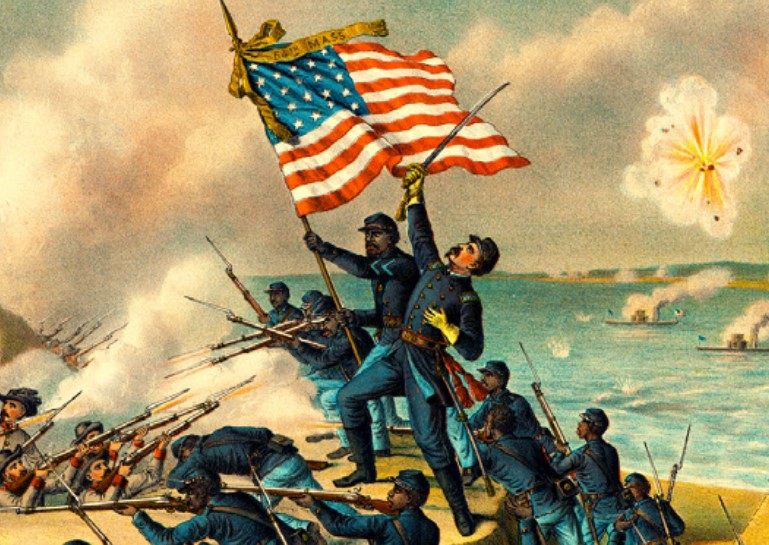The American Civil War is an event of world-historic significance. This revolutionary war, which consumed US society for four long and bloody years, overthrew slavery as a mode of exploitation and laid the ground for the rapid development of US capitalism. This episode in the class struggle graphically demonstrated the dynamics of revolution, and should be studied by all class-conscious workers and youth.
In this article from issue 38 of the In Defence of Marxism magazine, John Peterson of the International Marxist Tendency (IMT) in the United States looks at these titanic events that shaped world history.
The Civil War was four years of the most brutal warfare the United States has ever seen, followed by the smouldering revolution and counter-revolution of Reconstruction. It was the foundry that transformed our conception of this country from “the United States are” to “the United States is”. A clear conception of the significance of this period is essential if we are to understand the country as it exists today. As the great novelist of the American South, William Faulkner, put it: “The past is never dead. It’s not even past.”
As Marx explained: “Men make their own history, but they do not make it as they please; they do not make it under self-selected circumstances, but under circumstances existing already, given and transmitted from the past. The tradition of all dead generations weighs like a nightmare on the brains of the living.”
The events of 160 years ago have a direct bearing on the struggle against exploitation, racism and all forms of oppression, and the struggle for socialism today. The Black Lives Matter movement following the police killing of George Floyd was a forceful reminder that institutional racism is alive and well, that the fight against inequality and oppression cannot be separated from the fight against class exploitation, and that the only way to bring about serious, systemic change is through mass struggle.
Revolution and counter-revolution
As we prepare for the revolutions of the not-too-distant future, we must soberly analyse the revolutions and counter-revolutions of the past – not only the inspiring victories, but also the defeats and betrayals, the periods of demoralisation and reaction. The study of the revolution cannot be separated from the study of counter-revolution, as these processes are dialectically interrelated. We must study the inter- and intra-class dynamics, contradictions, and tensions, and follow the changing class and property relations as they develop within a given society.
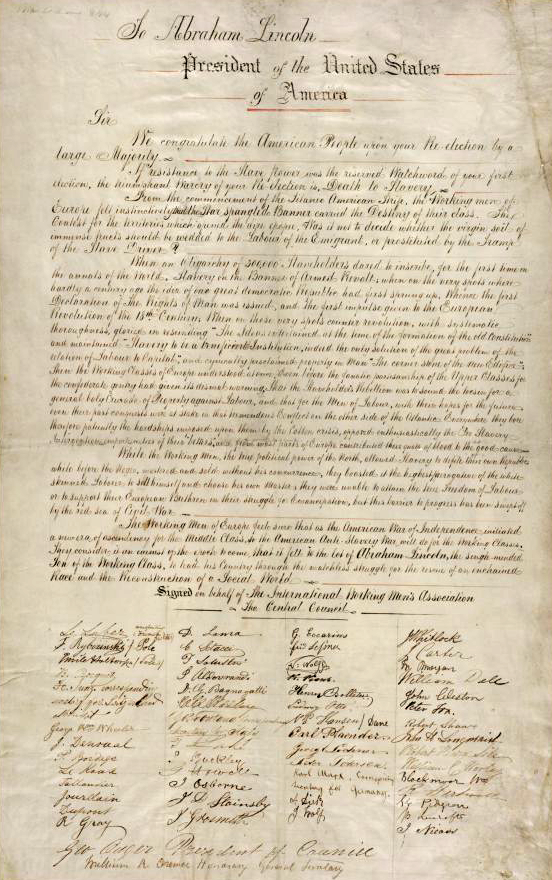 Marx wrote a letter to Abraham Lincoln, congratulating him on his reelection in 1864 / Image: public domain
Marx wrote a letter to Abraham Lincoln, congratulating him on his reelection in 1864 / Image: public domain
As Marxists, we are especially interested in understanding the role of the masses in these processes. Time and again throughout history, we’ve seen how, when deep divisions emerge at the summit of society, the masses sense an opportunity and rise up from below to seize their destinies in their hands. They forcefully put their stamp on the course of history, even if they don’t have a clearly worked out plan, or a leadership up to the tasks posed by events.
The First American Revolution, which saw thirteen colonies win independence from the greatest imperialist power of the age, is full of heroic examples of mass struggle and sacrifice. However, when it comes to the sheer drama of American history, nothing quite compares to the Civil War.
It is not for nothing that Marx called it “the greatest event of the age.” Engels referred to it as “the first grand war of contemporaneous history.” And Lenin, in his inimitable polemical style, wrote that only a pedant and an idiot could deny “the immense, world-historic, progressive, and revolutionary significance of the American Civil War of 1863-65!”
Marx and Engels took an enthusiastic interest in the war as it unfolded, carefully following its many economic, political, military, and diplomatic twists and turns. They produced dozens of extremely insightful articles and letters about these events, which are highly recommended. Marx even wrote a letter to Abraham Lincoln on behalf of the First International, congratulating him on his reelection in 1864, and nicely summing up his appraisal of events: “If resistance to the Slave Power was the reserved watchword of your first election, the triumphant war cry of your re-election is Death to Slavery.”
A contradictory process
Revolutions are always preceded by periods of converging economic, political, social, and often, military crises. Like earthquakes and volcanoes, these are nonlinear processes, flowing from accumulated contradictions and pressures that eventually reach a tipping point and unleash all the energy built up in the previous period.
The power of the masses is like a force of nature, like flood waters behind a dam. As the pressure builds up, even small cracks can lead to the rupture of the entire structure. Without a dialectical approach it is easy to drown in the facts and figures and fail to understand the most complex of social phenomena, including wars, revolutions, and counter-revolutions.
In its essence, the US Civil War was a titanic struggle between the historically progressive industrial capitalism of the North, and the plantation and slave-owning counter-revolution of the South.
But even this is a bit too simplistic, and we should not approach this or any other clash between revolution and counter-revolution in a one-sided way. Contrary to the official narrative, this was not a monolithic and united struggle of slavery-hating capitalists, anti-racist workers, and small farmers on the one side, fighting against a united horde of slavery-loving plantation owners and racist poor farmers on the other.
There were deep class contradictions on both sides of the sectional divide, including, of course, millions of slaves and hundreds of thousands of escaped slaves. There was deep-seated racism in every part of the country, including among many abolitionists. And although they were objectively fighting against slavery, a majority of northern whites were suspicious of slaves, and especially freed slaves, who were seen as competitors for jobs and land.
There were also big economic and cultural differences within the broader North-South sections themselves. For example, the economies and interests of Delaware and Maryland in the South were not the same as in Texas or Mississippi. The same applies to Northern states like Massachusetts or Connecticut as compared to states like Wisconsin or Minnesota, which were on the western frontier of that time.
And even though slaveholding had been abolished in New York decades earlier, the city’s financiers profited more than anywhere else from the slave trade. The mayor of New York City, Fernando Wood, seriously suggested to the City Council that it should declare itself a “free city” and act as a neutral commercial liaison between the North and the South. Wood was at the heart of the infamous Tammany Hall, and was keen to keep the revenues from the slave and cotton trade flowing, which greased the wheels of political patronage of the city’s Democratic Party machine.
The origins of the Civil War can ultimately be traced to the very founding of the country and the incomplete nature of the first American Revolution. Independence from Britain had been won, but many of the historical tasks typically associated with what Lenin referred to as the national-democratic revolution remained incomplete. Another revolution, another tremendous social upheaval and restructuring of the economy and society as a whole, was needed to facilitate the untrammelled development of American capitalism.
After decades of compromise with the centrifugal forces of Jeffersonian and Jacksonian “states’ rights” particularism, the inheritors of Alexander Hamilton’s federalists finally won the day under Lincoln. The war led to unprecedented centralisation in order to finance and mobilise the human and material resources required for victory: with tariffs, taxes, a military draft, the first national paper currency, and even partial nationalisation of the railroads and telegraphs.
But what truly made the Civil War a revolution is that it was not at all driven merely from above. There was massive participation by ordinary northern workers and small farmers, who fought to defend the union, and ultimately, to smash slavery. They did so under the banner of the Union and bourgeois liberty, inspired by religious righteousness and the revolutionary spirit of 1776. Many were European revolutionaries who had emigrated following the failed revolutions of 1848. Two hundred thousand German immigrants joined the Union army, many of whom had already cut their teeth on revolutionary armed struggle. Tens of thousands of revolutionaries from Ireland and other European countries also joined the struggle. In addition to these, the Northern ranks swelled with hundreds of thousands of slaves, who played a decisive role in their own emancipation – tens of thousands of them with arms in hand.
Accident, necessity and the role of the individual in history
It is ABC for Marxists that revolutions give expression to profound social and economic contradictions. But the precise outcome of such processes flows from a struggle of living forces, including countless accidental elements, and is by no means predetermined. And although the role of the individual in history is indubitable and can be decisive at certain nodal points of development, the main course of events is not decided by the subjective will of individual participants.
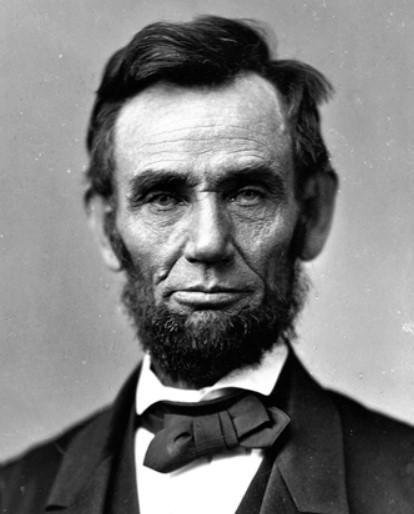 “I claim not to have controlled events, but confess plainly that events have controlled me.” / Image: public domain
“I claim not to have controlled events, but confess plainly that events have controlled me.” / Image: public domain
Abraham Lincoln instinctively understood this. As he put it: “I claim not to have controlled events, but confess plainly that events have controlled me.” His ideas and actions evolved dramatically over the course of the conflict, and offer a highly interesting example of reformism passing over into revolution. Initially, he adopted a largely legalistic approach, as he aimed to put down a regional rebellion while maintaining the status quo, including slavery. He was only a hardliner on the question of the extension of slavery into the territories.
However, he was eventually compelled by events to pursue a revolutionary war of destruction and expropriation against slavery, which was the root cause and support for the South’s revolt. Had he limited the struggle to reestablishing the old order, he would have almost certainly failed. But once he recognized the changed conditions and allowed himself to be swept along by the tide, he gave an impetus to the process in his own way, and helped transform it into fully a revolutionary struggle, which in turn took on a life of its own.
Class and property relations
Before the Civil War, capitalism had been dominant throughout the country for a very long time, on both sides of the Mason-Dixon line. The US had long been an integral part of the world market, and in the decades after the first revolution, its merchant capitalists had been transformed into capitalist manufacturers and industrialists.
Over the same period, the largely self-sufficient, independent household production of the “yeoman farmers” in the North had also been transformed. Due to a range of economic and social factors, above all, the growing pressures of the market, they had been compelled to become agrarian petty-commodity producers, or they had lost their land and become wage labourers, or in some instances, risen to the position of petty capitalists themselves.
The South also had its share of small farmers, some with land of their own, others who worked as tenants on the land of others, and still others who were landless and worked as itinerant agricultural labourers, or merely scraped out a bare existence on the fringes of society. There was some manufacturing in the South. In fact, there had been conscious efforts to expand this in the Antebellum years for fear of being totally dependent on Northern manufactured goods.
But the predominant mode of exploitation, and the top contributor to the Southern economy, was chattel slavery, which pumped out agricultural commodities to be sold for a profit on the domestic and world markets.
So while the capitalist mode of production was dominant in the country as a whole, the ruling class of each section based itself on very different modes of exploitation, and as a result, had increasingly divergent priorities and interests.
Everything turns into its opposite
Slavery had long played an oversized role in the accumulation and expansion of capital in the country as a whole. Slaves first arrived in the Thirteen Colonies in Virginia, in 1619, and by 1790, shortly after the Constitution was adopted, there were almost 700,000 slaves in the US, roughly one of every six inhabitants. Flowing from this, the South had largely dominated the federal government since the republic was founded, despite its far lower population.
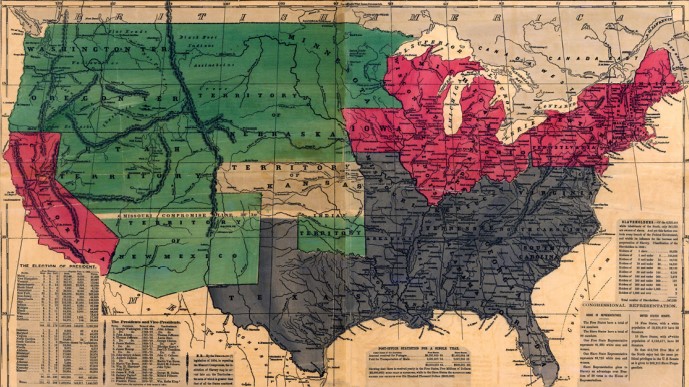 An 1856 map of the United States depicting the slave states (gray), free states (pink), U.S. territories (green), and Kansas (white) / Image: public domain
An 1856 map of the United States depicting the slave states (gray), free states (pink), U.S. territories (green), and Kansas (white) / Image: public domain
The Industrial Revolution in Britain and the rise of the cotton-mills created an insatiable demand for cotton. The invention of the cotton gin in 1793 revolutionized cotton production and fueled the need for growing numbers of slaves to expand cultivation of the labor-intensive crop. As a result, the slave population more than quadrupled to almost four million between 1790 and 1860, of which 90% of slaves were in rural areas, concentrated on the plantations. However, there were also many slaves living in urban areas or working in rural industry, with slaves accounting for roughly 20% of the population in most Southern cities. In Charleston, South Carolina, slaves and free blacks actually outnumbered whites.
The dependence of the Southern economy on slavery, producing raw materials for export, certainly produced immense profits for the “planters” and their financiers, but it also stifled further economic development. And although there were some innovations and changes introduced over the years, broadly speaking, the southern economy remained more or less the same in the 1850s as it had been in the 1820s.
In the North, on the other hand, the economy had evolved much more dramatically, with household production being transformed into small-scale manufacturing, and manufacturing transformed into full-on industry. As northern capital grew ever larger, the ascendant big bourgeoisie wanted political power commensurate with its rising economic might.
For well over half a century, two sections had had a symbiotic, if at times, strained relationship. Their interests had coincided in the struggle against the British, against the Shaysites and other internal rebellions in the years after the first revolution, and they were able to negotiate the joint sharing of power within the same state for several decades. But eventually, this mutually beneficial relationship hit its limits and was transformed into its opposite.
Once capitalism really took off on the continent, slavery was a far-less efficient use of land and labor. The slaveholders were also confronted with the challenge of keeping their slaves usefully occupied throughout the agricultural cycle, as well as when agricultural prices fluctuated. Their solution was to make their plantations as self-sufficient as possible not only in food production, but also in tool-making, blacksmithing, etc. This discouraged both petty and industrial commodity production in the lands they controlled. With growing international competition threatening their dominance of the cotton trade, geographic expansion was essential to their survival as a class. They needed more land to grow cotton or other useful ways to put their slaves to work, for example, in ranching and mining operations in the west.
But the territorial expansion of slavery posed a threat to the further expansion of industrial capital and the exploitation of wage labor. Not only did the Northern industrialists rely on the exploitation of wage labour, they depended on the expansion of agricultural petty-commodity production as their main market. That is, they needed small independent farmers with the means to buy the goods they manufactured, and it was precisely these people who came into direct conflict with the attempts to spread slavery to the Western territories. The North was therefore compelled by the dynamics of capitalist production to impose its own economic forms on the national state as a whole, including in its westward expansion, even if these aims were presented in moral or religious terms, or in the name of “freedom” in the abstract.
All of this represented a mortal threat to the “way of life” of the South, which was based on the so-called “peculiar institution” of chattel slavery. It is not within the scope of this article to recount the horrors of slavery, the Middle Passage from Africa to the Americas, or the history of the estimated 250 slave uprisings, both large and small, that took place in the US alone. Suffice it to say that slavery was not passively accepted by the enslaved, and that the millions of slaves and free Black people who called the United States home had developed their own cultural forms, communication networks, and methods of resistance.
Broadly speaking, however, by the 1850s, there were two very different socio-economic entities, two distinct national identities, forced to co-exist within the same nation-state – and this was untenable in the long-term. As Lincoln famously said in 1858: “A house divided against itself cannot stand; this government divided into slave states and free states cannot endure, they must all be free or all be slave; they must be one thing or the other.” A massive political crisis was inevitable. The framework of the original US Constitution and Bill of Rights had reached its limits and was about to burst in violent and dramatic fashion.
“A failure to compromise”
Among many other compromises intended to cobble a coherent nation out of thirteen very different colonies, the US Constitution included the mind-boggling Three-Fifths Compromise. This denied the humanity of slaves, yet counted them as three-fifths of a person when calculating a state’s population for the purpose of allocating seats in the House of Representatives and the Electoral College. The historian Shelby Foote – a not-too-thinly veiled Confederate sympathiser – blamed the Civil War on a failure of Americans “to do the thing we really have a genius for, which is compromise.”
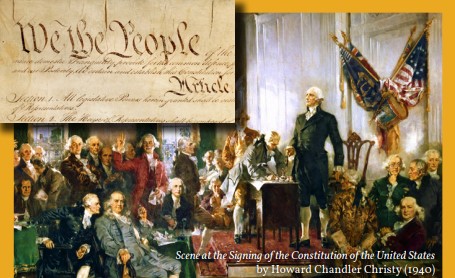 The framework of the original US Constitution and Bill of Rights had reached its limits / Image: public domain
The framework of the original US Constitution and Bill of Rights had reached its limits / Image: public domain
From a Marxist perspective, however, there can be no permanent compromise on fundamental class questions. In the final analysis, one class or another must hold and exercise power. One class or another must dominate political, economic, and cultural life. All great questions are ultimately decided through class struggle, at the workplace, in the streets, and when push comes to shove, on the battlefield – not at the ballot box, in Congress, or the judiciary.
As Abraham Lincoln understood: “In a choice of evils, war may not always be the worst.” All war is the continuation of politics by other means, and as Lenin explained, politics is concentrated economics. A civil war is not merely a military confrontation. It is, above all, a political and social struggle between and within different classes.
After the war, the so-called “Lost Cause” apologists for the Confederacy sought to romanticise and mythologize the Antebellum South. They referred to the conflict as the “War of Northern Aggression” and claimed it was all merely about defending states’ rights and the US Constitution. There is an element of truth in this, insofar as the Southern states fought for the right to exploit slave labor. It was also a defense of the Constitution, insofar as the Constitution, as originally adopted, did, in fact, allow and protect slavery.
This is what the Founders wrote in Article IV, Section 2 of the country’s governing document: “No person held to service or labor in one state, under the laws thereof, escaping into another, shall, in consequence of any law or regulation therein, be discharged from such service or labor, but shall be delivered up on claim of the party to whom such service or labor may be due.”
The words “held to service or labor” is code for slavery and indentured servitude, another form of exploitative bondage. So even before the Fugitive Slave Act of 1850, the states were constitutionally bound to return escaped human property to their owners. The Southern cause was ultimately an attempt to forcibly maintain the country at an earlier, even more vicious stage of its development for the benefit of a reactionary class of fewer than 400,000 slaveholders.
A war for slavery
It is an inconvenient fact for those who tried to muddy the waters after the war, that before the war started, they openly admitted that it was, in fact, all about slavery. They repeatedly and explicitly recognized and denounced the threat posed to slavery by the rising power of the North.
As an example, in South Carolina’s ordnance of secession, they complained that the federal government was not upholding laws passed to guarantee the sanctity of slave property, and decried “an increasing hostility on the part of the non-slaveholding States to the institution of slavery.”
And in his “Cornerstone” speech, given in Savannah, Georgia in March of 1861, the Vice President of the Confederacy, Alexander Stephens, clearly enunciated the real reason for secession: “Our new government is founded upon… the… idea; its foundations are laid, its corner-stone rests, upon the great truth that the negro is not equal to the white man; that slavery subordination to the superior race is his natural and normal condition. This, our new government, is the first, in the history of the world, based upon this great physical, philosophical, and moral truth.”
As Marx commented at the time: “The question of the principle of the American Civil War is answered by the battle slogan with which the South broke the peace. [Vice President of the Confederacy, Alexander] Stephens… declared in the secession Congress, that what essentially distinguished the Constitution hatched at Montgomery from the Constitution of the Washingtons and Jeffersons was that for now for the first time, slavery was recognized as an institution for good in itself, and as the foundation of the whole state edifice, whereas the revolutionary fathers, men steeped in the prejudices of the eighteenth century, had treated slavery as an evil imported from England and to be eliminated in the course of time.”
The only real difference between the US and the Confederate constitutions was that explicit language was added in several articles and sections making it clear that no “law denying or impairing the right of property in negro slaves shall be passed.” The irony is that, far from being all about states’ rights, before secession, the slave states wanted the federal government to protect slavery on their behalf. And for decades, it did. When this was no longer 100% guaranteed for all eternity, they wanted out of the Union.
As is evident from the speeches of Alexander Stephens and others, a very different morality had grown up in the South to justify that section’s society and convictions. The big plantation owners presented slavery as a benign institution, a blessing bestowed upon inferior subhumans by their racial superiors. They attacked the hypocrisy of the northern speculators and investors who made vast sums of money on the slave trade, though they owned no slaves themselves. They even ridiculed northern capitalists for not being able to feed, clothe, and guarantee employment to their workers, things that they, the benevolent slaveowners, graciously provided for their slaves. However, as is always the case in class society, it was always about private property and private wealth, no matter how it is dressed up.
On the eve of the war, slaves were the number one asset in US, accounting for roughly 16% of all household wealth. These human chattels were worth, according to their “commercial” price on the slave market, an estimated $3.5 billion dollars – more than all the railroads, factories, and banks in the entire country put together. By some estimates, that’s the equivalent of around $10 trillion in today’s money. Cotton was king and the textile mills in England and in the North had a voracious appetite for it. 80% of the world’s cotton, and 77% of the 800 million pounds of cotton consumed in the great factories in Great Britain was produced by slaves in the American South.
As a result, the Confederates thought they were holding some pretty strong cards when they decided to strike out on their own. They purposely withheld exports and even burnt 2.5 million bales of cotton at the start of the war, in a successful attempt to create shortages, and a miserably unsuccessful attempt to compel Britain to enter the war on their side, or to at least grant formal recognition.
In short, the four million humans who generated the vast majority of Southern wealth and a good proportion of Northern wealth were not slaves for the sake of it, or due to racism in the abstract. They were slaves to make profits for capital, which will happily rake in value from any and all forms of exploitation. Slavery was big money, and the racist poison that accompanied it reflected and was intended to justify that economic exploitation.
The coming storm
With the possible exception of fire-eating secessionists like William Yancey, militant abolitionists like John Brown, and the top general in the US Army at that time, Winfield Scott, very few people in the Antebellum years could have anticipated the cataclysm that was on the horizon. And none of them appreciated the profound social and economic changes that would result from the war.
Even after the first few states announced they were leaving the union, most people in the North assumed it was merely a case of political brinkmanship taken too far, a hard-line negotiating tactic to extract concessions. At most, they thought they were faced with a fairly minor regional “rebellion.”. They believed that without expending too much blood or treasure, they could reestablish the union on more or less the old lines. As for the South, many sincerely believed they could simply walk away from the United States and continue their system in more or less the same form, minus Yankee interference.
Not everyone in the South was for secession, and not everyone in the North favoured the forcible repression of the South. Some wanted Lincoln to just let the Southern states go. But events moved quickly, a critical mass was reached, and the time came when only muskets, cannons, horses, ironclads, and railroads could decide the issue.
A timeline to conflagration
As far back as 1787, even before the Constitution was formally in force, the question of slavery and its extension westward came up in the form of the Northwest Ordinance, which prohibited slavery in the Northwest Territory, which included the modern-day states of Michigan, Wisconsin, Ohio, Illinois, Indiana, and part of Minnesota. It was signed by George Washington, who of course, was himself a slave owner. The Louisiana Purchase of 1803 was a major territorial expansion and again posed the question: would these new territories be free or slave?
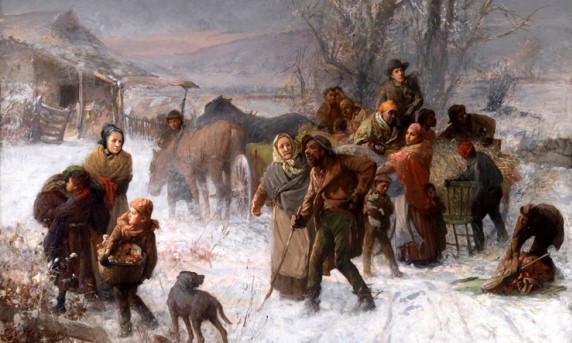 The Underground Railroad was a growing network of activists and financial backers who helped slaves escape / Image: public domain
The Underground Railroad was a growing network of activists and financial backers who helped slaves escape / Image: public domain
In 1820, the Missouri Compromise allowed for the admission of Missouri to the Union as a slave state, in exchange for the admission of Maine as a free state, to ensure that the delicate balance of power between free and slave states was maintained. Tensions had been relieved for the moment, but it set a precedent for the further expansion of slavery. The years continued to pass, the economy and population kept growing, and the interests of the two sections continued to diverge.
Concrete questions about the role of government flowed from these differences. For example, should the federal government raise money to invest in major infrastructure projects like railroads, canals, ports, etc.? Or should it seek to lower government expenditures and let the states attend to such concerns? Since the South believed it could get along just fine with a few ports, railroads, and waterways, politicians from that section tended to oppose the major infrastructure programs desired by the North.
As another example, the North wanted the federal government to establish tariffs to protect and nurture its young industries, while the South preferred free trade to allow for cheap imports of luxury goods. Due to the federal system, policies set by the central government affected all states equally. Tensions flared again with the Tariff of 1828, a tax on imported goods passed to defend the Northern industrialists who were finding it hard to compete with the cheap commodities coming in from Britain.
This led to the Nullification Crisis of 1832–33, with South Carolina already raising the spectre of secession. Fear and anxiety in the South were sky high at that time after Nat Turner’s 1831 Rebellion in Virginia, in which over 60 white people were killed. In response, the slavers had responded: with malicious brutality and cold-hearted terrorism. Turner was hanged, drawn and quartered, beheaded, and buried in an unmarked grave. As many as 200 other slaves, most of whom had nothing to do with the uprising, were massacred to set an example.
Then came the annexation of Texas into the Union in 1845, and the predatory war with Mexico from 1846 to 1848. The US won that “wicked” war, as Ulysses S. Grant later called it, and expropriated roughly half of Mexico, including modern-day California, Nevada, Utah, and chunks of Arizona, New Mexico, Colorado, and Wyoming. Yet again, the question was posed: Would these territories be free or slave? This was now a life or death question, as by now, the two sections’ interests were irreconcilably opposed.
In 1850 came yet another major compromise in the form of the Fugitive Slave Act, which was largely a response to the Underground Railroad, a growing network of activists and financial backers who helped slaves escape, mainly to the North, though it is worth noting that there was also a network that helped several thousand slaves escape south into Mexico.
Reinforcing the provisions in the Constitution, the Fugitive Slave Act decreed that all slaves were to be returned to their owners regardless of what state they were caught in – and that the federal government would enforce this throughout the country. This was to compensate for the admission of California as a free state, the incorporation of which was urgent due to the discovery of gold in 1849. Laws, order, and infrastructure had to be established in the Wild West in order to get the gold back East. However, just as there had been resentment in the South over the passage of protective tariffs, there was tremendous resentment in the North over the Fugitive Slave Act, which effectively deputized slave catchers in every part of the country.
In 1852, came the publication of the book Uncle Tom’s Cabin. It detailed the horrors of slavery, further galvanizing abolitionist sentiment in the North and infuriating the South. Then came the Kansas-Nebraska Act of 1854, which carved two new territories out of the west as a prelude to establishing two new states, a necessary step towards building a transcontinental railroad. This led to “Bleeding Kansas,” as pro- and anti-slavery forces fought a preview of the civil war over whether the new states would be free or slave.
Adding to the volatile mix, the Republican Party was founded in 1854 as a free-soil and free-labor party opposed to the expansion of slavery. As its first presidential candidate in 1856, it ran the famous explorer John C. Fremont, who was seen as a radical abolitionist by the South. Also in 1856, Massachusetts Senator, Charles Sumner, was brutally beaten with a cane in the Senate chamber by Representative Preston Brooks of South Carolina for insulting the honour of the South.
Then, in 1857, the infamous Dred Scott case came before the Supreme Court, which ruled that since black people were not US citizens, they could not enjoy any of the rights of citizenship. Therefore, slaves brought by their owners to free states remained slaves, even if slavery did not exist in that state. This effectively made slavery legal nationwide, opening the door for the spread of slavery across the continent.
One crisis was layered upon another, and the impetus towards a general conflagration was accelerating. This was compounded by the so-called economic Panic of 1857, a classical crisis of capitalist overproduction. But what tipped the balance once and for all was the indomitable abolitionist, John Brown – the “meteor of the war” – as he was called by Herman Melville.
The abolitionists and John Brown
The abolitionists were generally a minority political movement prior to the Civil War, the first among them being the Mennonites and Quakers. Abolitionist sentiment was particularly fervent in New England and in places like New York, but it was also gaining traction in parts of the West and there were even some abolitionists in the South. This was an extremely dedicated and passionate group of people, and included religious leaders like Henry Ward Beecher, newspaper editors like William Lloyd Garrison, and some who were both, like Elijah P. Lovejoy, an early martyr of the abolitionist cause.
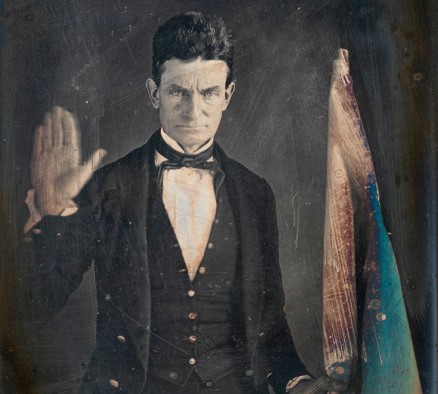 Revolutionary abolitionist John Brown said in regard to slavery: “what is needed is action – action.” Image public domain
Revolutionary abolitionist John Brown said in regard to slavery: “what is needed is action – action.” Image public domain
Most abolitionists simply wanted to reform slavery out of existence, not actually abolish it overnight. And despite opposing slavery, many of them didn’t believe there could be genuine equality between blacks and whites and supported resettling freed slaves in Africa.
Despite the relative weakness of the movement, however, it struck fear into the hearts of Southern slave owners. Almost as much as they feared slave uprisings, they feared losing control of the federal government to those with even mild abolitionist sentiments – as this would mean the beginning of the end of slavery.
Some abolitionists were activists on the Underground Railroad, like Harriet Tubman, who heroically escorted an estimated 300 slaves to freedom over the course of her 19 forays into the South. Others were consistent revolutionary democrats, like the incomparable orator and escaped slave, Frederick Douglass. Then there was John Brown, a revolutionary abolitionist and religious fanatic who believed that “what is needed is action – action.”
Brown fervently believed in the equality of blacks and whites and understood that the slave-owning aristocracy wasn’t going to give up its property without a fight. He had played a prominent role in Bleeding Kansas, including the Pottawatomie Creek massacre, in which five pro-slavery activists were hacked to death with swords. In 1858, he held a meeting in Chatham, Ontario as part of his plan to prepare a series of raids into Appalachia to free and arm thousands of slaves. His aim was to establish a republic of liberated bondsmen that would terrorize the South and make the continuation of slavery economically unviable.
These plans culminated in his ill-fated raid on the US federal arsenal at Harpers’ Ferry 1859. In one of those twists of history in which the Civil War is so rich, it was Robert E. Lee, at that time a Lt. Col., who led a detachment of Marines that captured Brown and his comrades. Despite having failed, John Brown understood that he could be more powerful in death than in life. As he put it: “I have been whipped as the saying is, but I’m sure I can recover all the lost capital occasioned by that disaster; by hanging only a few moments by the neck…”
And as he wrote in a note slipped to his jailer on his way to the gallows: “I, John Brown, am now quite certain that the crimes of this guilty land can never be purged away but with blood. I had as I now think, vainly flattered myself that without very much bloodshed, it might be done.”
In the words of Frederick Douglass: “His zeal in the cause of freedom was infinitely superior to mine. Mine was as the taper light, his was as the burning sun. Mine was bounded by time. His stretched away to the silent shores of eternity. I could speak for the slave. John Brown could fight for the slave. I could live for the slave. John Brown could die for the slave.” And when Malcolm X was asked if white people could join his Organisation of African Unity, he replied: “If John Brown were still alive, we might accept him.”
John Brown’s revolt would capture the imagination of the masses throughout the North. Almost from the outset of the war, troops sang “John Brown’s Body” around the campfire and at public reviews. And it was at one of these reviews that the poet and abolitionist, Julia Ward Howe, would hear this revolutionary anthem, inspiring her to write the “Battle Hymn of the Republic” to the same tune. Many other, even more explicitly revolutionary versions were also penned, offering an insight into the revolutionary fervour that took hold at all levels of society during the war.
Meanwhile, many in the South had already been openly contemplating secession for years. Some even thought that if they left the Union, they could build a massive slave empire by conquering Mexico, the Caribbean, and perhaps even South America. After all, Cuba already had 400,000 slaves, plenty of undeveloped land, and the plantation owners there looked towards the US for support in their struggle against Spain.
But John Brown’s raid on Harpers’ Ferry overflowed the cup. Here was proof positive that white northerners wanted to incite servile revolt, expropriate the South’s wealth, and destroy their very civilisation. Across the slave states, plans were made, arms purchased, and militias drilled in preparation for a decisive showdown with the North.
The politics of crisis
Prior to the rise of the Republicans, the Democrats and the Whigs were the two dominant political parties in the country. The Democrats were traditionally for territorial expansion to encompass the whole of North America, while the Whigs were largely for internal improvements within the existing boundaries, with federal investment in infrastructure, education, industry, etc. By the 1850s, both the Whigs and Democrats had started to divide along sectional lines.
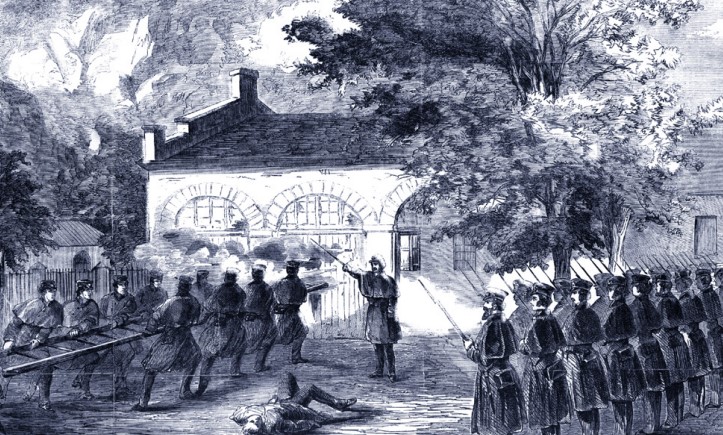 For many in the South, John Brown’s raid on Harpers’ Ferry was proof that white northerners wanted to incite servile revolt / Image: public domain
For many in the South, John Brown’s raid on Harpers’ Ferry was proof that white northerners wanted to incite servile revolt / Image: public domain
All parties express class interests. New parties emerge and old ones fall apart or reinvent themselves when economic and social forces are transformed, often imperceptibly, over the previous period. Such periods are marked by increased instability and a flailing around for ideas, leaders, and political expression that can break the impasse and point the way forward. It is in this context that a wild and wonderful series of parties and movements emerged in the 1850s, from the nativist Know-Nothing Party to the Free Soil Party, and of course, the Republican Party.
The Republicans were an almost purely sectional party and mainly represented the northern industrialists, small shopkeepers, farmers, and abolitionists. Their platform built on the old Whig Party program, favouring federal investment in infrastructure, tariffs to encourage “the development of the industrial interests of the whole country”, and “liberal wages” for the working man. Most Republican politicians were not motivated by love for black people or for workers. Rather, they understood, consciously or unconsciously, that slave labor and the expansion of slavery were an impediment to the consolidation and expansion of capitalism.
Just six years after the party was founded, in 1860, Abraham Lincoln was elected president on the Republican ballot line. And if John Brown’s actions overflowed the cup of secession and war, Lincoln’s election shattered the cup into a million pieces. Upon his election, the Massachusetts abolitionist Charles Francis Adams proclaimed: “The great revolution has actually taken place… The country has once and for all thrown off the domination of the slaveholders.”
However, it would be several months before Lincoln took the oath of office. The sitting president, the Democrat James Buchanan, was a “dough face,” a Northerner who sympathised with the South. He was completely paralysed by the crisis. In his view, it was illegal for the South to secede, but it was equally illegal for the federal government to stop secession by force. What to do?
Lincoln had been elected in a four-way race with just under 40% of the vote – and he wasn’t even on the ballot in 10 southern states. Although he despised slavery personally, he was a “moderate” and sought only to limit the expansion of slavery into the territories, not to end the institution where it already existed and was protected by the Constitution. But everyone knew that the end of expansion spelled the eventual death of slavery altogether.
As Marx wrote at the time: “A strict confinement of slavery within its old terrain, therefore, was bound according to economic law to lead to its gradual extinction, in the political sphere to annihilate the hegemony that the slave states exercised through the Senate, and finally to expose the slaveholding oligarchy within its own states to threatening perils from the ‘poor whites.’ In accordance with the principle that any further extension of slave Territories was to be prohibited by law, the Republicans therefore attacked the rule of the slaveholders at its root. The Republican election victory was accordingly bound to lead to open struggle between North and South.”
Secession
Many so-called ‘fire-eaters’ in the South actually celebrated Lincoln’s election – because they knew it would accelerate the tendency towards secession. They truly believed that they were the revolutionaries, following in the footsteps of the country’s founding generation, defending themselves and the Constitution against tyrannical attempts to despoil citizens of their rightful property. Some even thought that the North had de facto seceded from the agreed-upon union, which clearly sanctioned slavery, and that the government at Washington had been usurped by a bunch of Republican radicals. Others believed the US Constitution was a failed experiment, and they wanted an even more explicitly pro-slavery constitution in its place, as we’ve seen.
Both sides appealed to the Constitution as they wanted it to reflect their class interests. By that time, however, that piece of paper reflected an outdated balance of forces. Only a bloody clash of arms and significant changes to the Constitution could establish a legal framework for the continuation of the United States on a new basis.
Nonetheless, until the very last moment, elements on both sides held out hope that some kind of agreement could be reached. Either that further protections for slavery could be guaranteed within the union, or that an amicable separation could be negotiated, including a gentleman’s agreement over what to do with federal property within the seceding states.
Others in the South wanted to present the incoming Lincoln administration with a fait accompli, which would limit his room for manoeuvre and pressure other slave states to join their cause. To this end, South Carolina declared it was seceding from the union on 20 December 1860, several months before Lincoln’s inauguration. It was followed in relatively quick succession by the main Cotton Belt states of Mississippi, Florida, Alabama, Georgia, Louisiana, and Texas, and eventually four others, for a total of 11 states that eventually declared they were forming a new nation. This, out of a total of 33 states in the Union at that time.
In response, Lincoln took a pragmatic, measured, and diplomatic approach, in large part for fear of provoking key border states like Virginia, Kentucky, Missouri, and Maryland, who had not yet seceded. His hope was that pro-Union sentiment in the South would eventually assert itself and force a quick reunion. When a well-wisher told Lincoln he was sure that god was on his side in the conflict, the president quipped: “I hope to have god on my side, but I must have Kentucky.” This neatly sums up the political, economic, and strategic importance of the border states.
In his first inaugural speech, Lincoln did his best to be all things to all people, offering an olive branch to the South, while refusing to accept that any states had left the Union, no matter what they declared. Secession represented the veto and tyranny of the minority over the majority. The Union had been entered into by collective agreement and the individual states could not unilaterally dissolve it. Although he put the onus for secession and violence on the Southern states themselves, he was firm in declaring that he would “hold, occupy, and possess the property and places belonging to the Government.”
This was a clear reference to Fort Sumter, a federal fort occupied by US troops, which happened to sit at the entrance of the harbour of Charleston, South Carolina. Though not of decisive strategic importance, Sumter had come to symbolise all federal laws, property, and the union in its entirety.
But not even the most carefully chosen words by the most eloquent of all American presidents could close the Pandora’s box that had already been opened. Several weeks earlier, on February 18, Jefferson Davis had been inaugurated as president of the Confederate States of America and the two entities were on a collision course. As the historian Bruce Catton put it: Jefferson and Lincoln were “the rival leaders of two nations in a land that could hold only one.”
After months of tension, Fort Sumter was finally bombarded by Confederate forces on 12 April 1861. Shortly thereafter, Lincoln called for troops to suppress the rebellion. The Rubicon had been crossed, the die had been cast, and only open war could decide the question now. And although Kentucky, Missouri, Maryland, and Delaware remained tenuously in the union, the call for troops to “coerce” the South pushed Virginia, Arkansas, North Carolina, and Tennessee into the Confederacy.
The secession of Virginia was particularly decisive, and all but guaranteed a long and bloody war as it had the largest economy and population of all the slave states. In a reflection of the contradictory nature of the Southern states, the western part of Virginia proceeded to secede from the state and formally rejoined the union in 1863 as the state of West Virginia.
The outbreak of war
Contrary to what Lincoln and others in the North had assumed, the start of open hostilities cut across any residual unionist sentiment and actually pushed the majority of Southerners together, though there were, of course, continued class contradictions, people who opposed the war, desertions, mutinies, and even bread riots in the Confederate capital of Richmond. But on both sides of the divide, there was mass enthusiasm for the war, and in many ways, the population was driving the politicians and even military policy itself.
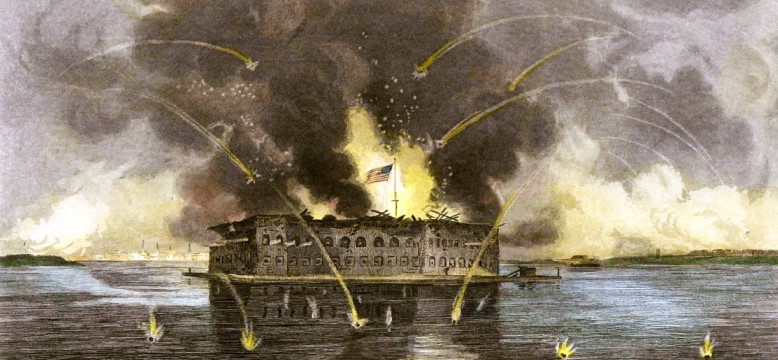 Fort Sumter was bombarded by Confederate forces on 12 April 1861 / Image: public domain
Fort Sumter was bombarded by Confederate forces on 12 April 1861 / Image: public domain
Several decades later, Leon Trotsky was in Vienna at the outbreak of World War I. This is how he described the mood of the masses, who had no inkling of the horrors to come and were infected at that moment with patriotism and nationalism: “The people whose lives, day in and day out, pass in a monotony of hopelessness are many; they are the mainstay of modern society. The alarm of [war] mobilisation breaks into their lives like a promise; the familiar and long-hated is overthrown, and the new and unusual reigns in its place. Changes still more incredible are in store for them in the future. For better or worse? For the better, of course what can seem worse to [an ordinary person] than ‘normal’ conditions?”
A similar mood was prevalent in both the North and the South as hundreds of thousands mobilised to join what they assumed would be a short and glorious little adventure.
The situation was particularly tense in the border states, slave states that had not seceded from the union, as well as in those parts of seceded states that had strong unionist sentiment. Winning or maintaining the allegiance of as many states as possible was critical to both sides in this delicate, high-stakes game of political manoeuvring.
As we’ve seen, Western Virginia seceded from Virginia outright to eventually form a new state. In other areas, there was, in effect, a civil war within a civil war, especially in places like Missouri, but also parts of Kentucky, Eastern Tennessee, and elsewhere. In states like Maryland, regiments were raised to fight on opposite sides of the conflict. The conception of the Civil War as a war between brothers was literally true in many of these areas. At Gettysburg, for example, Confederate and Union soldiers from Maryland confronted each other on Culp’s Hill, calling out greetings to their former friends and neighbours as they killed each other.
While the South needed all the support they could get, holding the border states was equally vital for the Union, both economically and strategically. As Lincoln wrote to a supporter in September of 1861: “I think to lose Kentucky is nearly the same as to lose the whole game. Kentucky gone, we can not hold Missouri, nor, as I think, Maryland. These all against us, and the job on our hands is too large for us. We would as well consent to separation at once, including the surrender of this capital.”
Washington, DC is surrounded by Virginia and Maryland, both slave states, but only one of which seceded. The threat posed to the capital and to Lincoln and the rest of his government was extremely high in the first few weeks of the war, and the only way to get loyal troops to defend the city ran through Baltimore, where pro-Confederate sentiment ran high. Despite the intense shelling, no one was killed at Fort Sumter, so the first blood of the war was shed on 19 April 1861, when a secessionist mob in Baltimore attacked Massachusetts troops bound for Washington. Four soldiers and 12 civilian rioters were killed.
Although Lincoln was trained as a lawyer and approached many things legalistically, he wasn’t about to let mere pieces of paper lead to inaction and the dissolution of the Union. To keep states like Maryland and Missouri in the Union, and to defend the Constitution as a whole, Lincoln was more than willing to bend certain aspects of that document beyond recognition, waging war by any means necessary to ensure the survival of his government and his country.
This included the suspension of habeas corpus in parts of the country, the creation of a secret service, an internal passport system for citizens, and the arrest and imprisonment of pro-Confederate dissenters, including the mayors of Baltimore and Washington, DC, Congressman Henry May, former Kentucky governor Charles Morehead, and many Northern newspaper editors. While it is not clear exactly how many people the government arrested for anti-war protests during the war, estimates range from 13,000 to 38,000.
On the surface, this appears to be a clear-cut condemnation of Lincoln, who seemingly behaved like a tyrant. But as Trotsky explained, the end justifies the means if the end itself is justified – even if those carrying out the means aren’t entirely clear what their end is. In the case of Lincoln and the Civil War, a revolutionary war to uproot slavery was, indeed, a justified end. Or, to paraphrase the Radical Republican Thaddeus Stevens, the laws of war superseded the laws of the Constitution.
To achieve all of this, Lincoln had to handle his friends, rivals, cabinet, generals, media, and public opinion with Machiavellian political genius, in the very best and original sense of that word. His careful, step-by-step balancing act between all the different pressures and players – most of whom thought they were smarter and better qualified than this backwoods country lawyer – is truly unparalleled in the whole of American history.
“The coming fury”
The North’s basic strategy for the war was the Anaconda Plan, devised by the Union’s General-in-Chief at the start of the war, Winfield Scott. Though it was mocked in the press by both sides, in broad strokes, it is what eventually led to military victory – along with the eventual transformation of the war into one of revolutionary liberation. In its essence, the plan called for the coordinated strangulation of the South through the combined pressure of Union land and naval forces. A maritime blockade of the Confederate coastline and a concerted push down the Mississippi River to take control of that key waterway would effectively split the Confederacy in half militarily and economically.
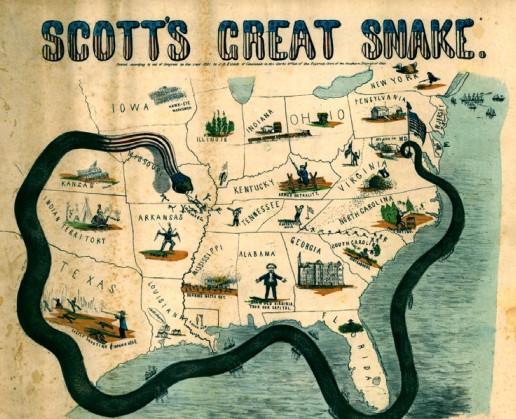 An illustration of Winfield Scott’s Anaconda Plan, printed in 1861 / Image: public domain
An illustration of Winfield Scott’s Anaconda Plan, printed in 1861 / Image: public domain
At the start of the war, the Union army was just 16,000 strong, and most of them were stationed in the West. A healthy chunk of the West Point-trained officer corps – though by no means all of the best military cadres – went over to the Confederacy. The South got people like Robert E. Lee, Stonewall Jackson, James Longstreet, and J.E.B. Stewart. But the North got Ulysses S. Grant, William Tecumseh Sherman, Philip Sheridan, and despite his many faults, the master organiser, George McClellan.
Both sides had their fair share of military dilettantes and incompetent political generals, who were in command merely because they had the wealth and wherewithal to raise and equip their own units. Many in the Confederacy believed Northerners to be soft and effete, unlike the fiery and martial people of the South.
But as George Ticknor wrote from Boston shortly after the bombardment of Fort Sumter, there was “much enthusiasm [in the North], much deep earnestness. Men and money are profusely offered; the best blood among us volunteering and going, and money untold following them… We have been slow to kindle; but we have made a Nebuchadnezzar’s furnace of it at last, and the heat will remain, and the embers will smolder, long after the flames that now light up everything shall cease to be seen or felt.”
And as William T. Sherman presciently told a Southern friend in Louisiana in the days after South Carolina announced it was leaving the Union:
"You people of the South don’t know what you are doing. This country will be drenched in blood, and God only knows how it will end. It is all folly, madness, a crime against civilization! You people speak so lightly of war; you don’t know what you’re talking about. War is a terrible thing!
You mistake, too, the people of the North. They are a peaceable people but an earnest people, and they will fight, too. They are not going to let this country be destroyed without a mighty effort to save it… Besides, where are your men and appliances of war to contend against them? The North can make a steam engine, locomotive, or railway car; hardly a yard of cloth or pair of shoes can you make.
You are rushing into war with one of the most powerful, ingeniously mechanical, and determined people on Earth – right at your doors. You are bound to fail. Only in your spirit and determination are you prepared for war. In all else you are totally unprepared, with a bad cause to start with. At first you will make headway, but as your limited resources begin to fail, shut out from the markets of Europe as you will be, your cause will begin to wane. If your people will but stop and think, they must see in the end that you will surely fail."
After Fort Sumter, Lincoln had called for 75,000 three-month volunteers. But he was eventually compelled to call for another 42,000, and then another 500,000, along with extending the term of enlistment to three years and instituting a national draft. By the end of the war, more than 2.1 million people had served in the Union army, which was the largest, best trained, and equipped military force on the planet. Significantly, roughly 180,000 of these were black troops, most of them former slaves. Another 750,000 people served in the Confederate army.
It was a colossal mobilisation on both sides. And while the early engagements were plenty bloody by the standards of earlier wars, it soon became clear that this was not going to be an easy or short war, and that the carnage was going to reach unimaginable levels.
A new kind of war
As Ulysses S. Grant later wrote in his extraordinary memoirs: “Up to the battle of Shiloh, I as well as thousands of other citizens believed that the rebellion against the government would collapse suddenly and soon [if] a decisive victory could be gained over any of its armies. [But after Shiloh,] I gave up all idea of saving the Union except by complete conquest.”
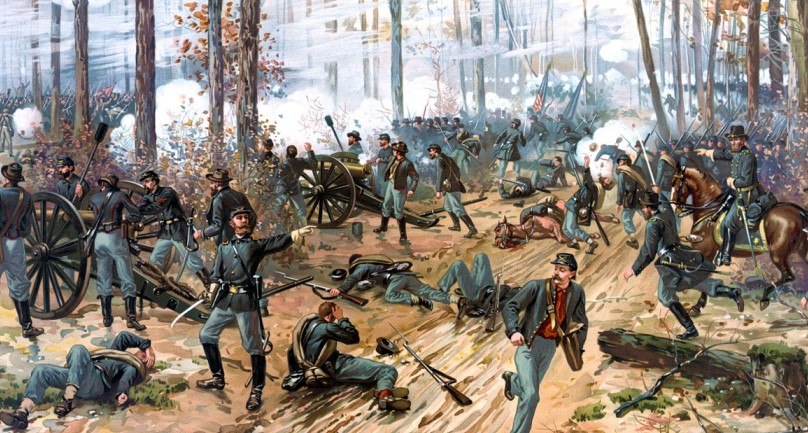 "[After the Battle of Shiloh,] I gave up all idea of saving the Union except by complete conquest." / Image: Adam Cuerden
"[After the Battle of Shiloh,] I gave up all idea of saving the Union except by complete conquest." / Image: Adam Cuerden
In April of 1862, near a small country church in southwestern Tennessee known as Shiloh – which, incidentally, means “place of peace” in ancient Hebrew – more than 13,000 Union soldiers and 10,000 Confederates were killed or wounded, more than in all previous American wars combined. By contrast, there had been some 4,750 total casualties at the first Battle of Bull Run, the first major engagement of the war, a disastrous Union defeat fought the previous summer on the outskirts of Washington, DC.
The nation was horrified by Shiloh and there was big pressure on Lincoln to relieve the commanding general, Ulysses S. Grant from duty. But Lincoln sensed something important in Grant and stood behind him. As he put it, “I can’t spare this man; he fights.”
On another occasion, when unsubstantiated complaints were raised about Grant’s alleged drinking while on duty, Lincoln is reported to have said:
“But can you tell me where he gets his whiskey?”
“We cannot, Mr. President. But why do you desire to know?”
“Because, if I can only find out, I will send a barrel of this wonderful whiskey to every general in the Army.”
These small anecdotes provide a wonderful insight into Lincoln as a leader. He knew people, and he knew how to make the best of their talents and abilities despite their weaknesses, how to build a team out of contradictory personalities and interests, and he had no problem sharing credit with others as long as the job was done and was done right.
Many of the most famous battles, including Antietam, Fredericksburg, Chancellorsville, Gettysburg, Wilderness, Spotsylvania Courthouse, Cold Harbor, and the Battle of the Crater, took place in the Eastern theatre, in Virginia and Maryland. But there was plenty of bitter and bloody fighting in the Western theatre, in Tennessee and Georgia, at places like Shiloh, Stone’s River, and Chickamauga.
Many Union generals sympathized with slavery and the South and actively undermined Lincoln’s policies. They envisioned a return to the status quo after an overwhelming show of force – not a decisive victory and radical change in social relations. Top generals such as George B. McClellan, Ambrose Burnside, and Joseph Hooker overestimated the enemy, or were simply out of their depth, and froze up in the face of the enormous responsibility on their shoulders.
As an example, McClellan succeeded in building up a magnificent, well-drilled, and expensive force, the Army of the Potomac, but he kept finding excuses not to actually use it, partly out of fear of losing it. This led an exasperated Lincoln to exclaim in the Spring of 1862: “If General McClellan does not want to use the Army, I would like to borrow it for a time, provided I could see how it could be made to do something.”
Marx was even sharper in his criticism, describing McClellan’s generalship as “itself sufficient to secure the downfall of the strongest and best disciplined army.” This weakness of the Northern generals however, had according to Marx a political and class basis:
"McClellan and most of the officers of the regular army who got their training at West Point are more or less bound to their old comrades in the enemy camp by the ties of esprit de corps. They are inspired by like jealousy of the parvenus among the ‘civilian soldiers.’ In their view, the war must be waged in a strictly business-like fashion, with constant regard to the restoration of the Union on its old basis, and therefore must above all be kept free from revolutionary tendencies affecting matters of principle. A fine conception of a war that is essentially a war of principles! The first generals of the English Parliament fell into the same error. ‘But,’ says Cromwell, ‘how changed everything was as soon as men took the lead who professed a principle of godliness and religion!’"
The parallel with the first stages of the English Revolution is particularly apt. Here, the struggle against the monarchy was originally led by Parliament, the members of which wasted much time vacillating and trying to find common ground with the royalist camp. Once Cromwell and the more revolutionary elements took over leadership of the revolution, however, things accelerated quickly. It not only strengthened the revolution on the battlefield, but also galvanised mass support for Cromwell’s Model Army among the masses up and down the country.
Likewise in the US, due to political vacillation and to other leadership issues, the fighting went fairly badly for the Union in the East for the first two years, and there were extreme swings in northern morale and confidence. However, the mass of the population, including the soldiery, was resolutely behind the war, and wanted it seen to the end.
By contrast, gains were steadily made in the West, where Ulysses S. Grant’s tactical, strategic, and operational genius, bulldog-like grit and tenacity, coolness under fire, mastery of logistics, and personal familiarity with the enemy commanders he faced, led to one Union victory after another, including the taking of Fort Henry in Kentucky and Fort Donelson in Tennessee. Grant’s military philosophy was straightforward: “The art of war is simple enough. Find out where your enemy is. Get at him as soon as you can. Strike him as hard as you can, and keep moving on.”
Grant versus Lee
Before the war, no one could have imagined that Ulysses S. Grant would rise to command all of the Union’s military forces and eventually become President of the United States. Despite being a West Point-trained cadre of the officer corps, he had left the army under a cloud of rumours over his alleged alcoholism.
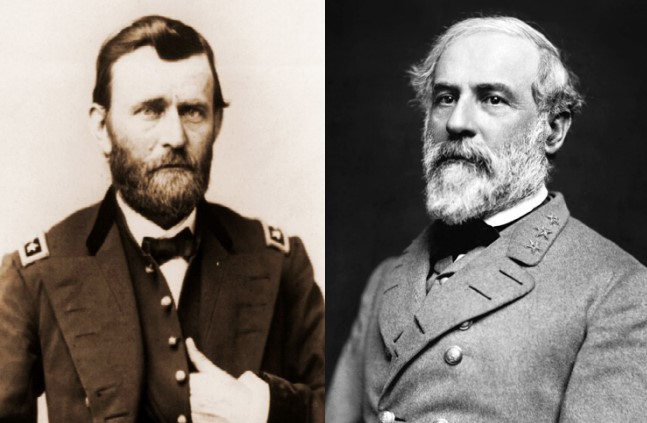 Ulysses S. Grant (left) and Robert E. Lee (right) / Image: public domain
Ulysses S. Grant (left) and Robert E. Lee (right) / Image: public domain
On the Confederate side, the most famous general was without a doubt, Robert E. Lee. He was a so-called ‘gentleman warrior’ who allegedly hated slavery personally but fought nobly to defend his beloved home state of Virginia. But the reality about his character is somewhat different, and in this author’s opinion, as well as in the opinion of Ulysses S. Grant, he is also overrated as a military commander.
Despite declaring before Fort Sumter that he would free all the slaves if that would save the union and prevent a war, Lee saw black people as inferiors requiring the firm, civilizing hand of white people. As a plantation owner, he separated slave families – a punishment more cruel than physical beatings. There were plenty of those too. After two of his runaway slaves were recaptured, not only did he have them whipped, he had saltwater literally poured into the lacerations.
Compare this to Ulysses S. Grant. Sometime in the 1850s, Grant had acquired a slave named William Jones from his father-in-law, who owned a medium-sized plantation and as many as 30 or so slaves. Grant worked side by side with Jones and other slaves on his modest homestead, which included a hand-built cabin with the unironic name of “Hardscrabble.” On 29 March 1859, Grant went to the St. Louis Courthouse and wrote a paper of manumission legally freeing Jones from slavery. Grant was in dire economic straits at the time, and could have sold Jones for $1,000 or more, which was a lot of money at that time.
As for their military prowess, although Lee exhibited moments of tactical genius on the battlefield, he also made his fair share of mistakes, some of them quite serious. Perhaps most importantly, Lee had a far more limited vision than Grant when it came to broader strategic thinking. This difference largely stemmed from the different class interests expressed by these generals, as well as their own class backgrounds.
Lee was about as blue-blooded as you can get in the US. The plantation-owning son of a Revolutionary War hero, he had married the daughter of George Washington’s adopted son. Grant, on the other hand, was the son of a tanner, a failed farmer and small businessman, who at a low point in his life had been forced to sell cartloads of firewood just to survive. When the war started, he was working as a clerk in his father’s leather shop in Galena, Illinois.
“Contrabands”
Early in the war, fugitive slaves were actually returned to their Confederate owners when they crossed over to Union lines. They were, after all, “animate property” and the rights of property had to be respected. But in May of 1861, three slaves being used to build Confederate defenses crossed over the Union lines at Fort Monroe in Hampton Roads, Virginia. Instead of being returned to slavery, General Benjamin Butler held them as “contraband of war,” just as a shipment of guns or ammunition would be if intercepted at sea.
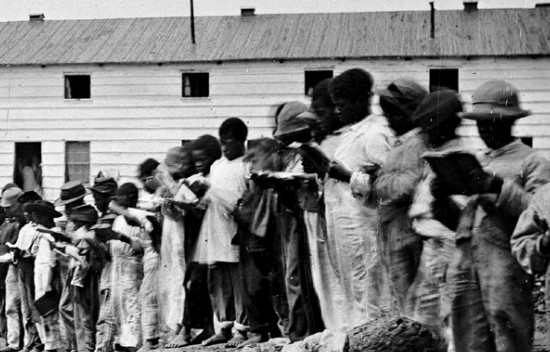 A photograph of a “contraband” school, taken some time between 1860 and 1865 / Image: Matthew Brady
A photograph of a “contraband” school, taken some time between 1860 and 1865 / Image: Matthew Brady
Never mind that Lincoln didn’t recognize the Confederacy as a foreign power, or that it was unclear who actually owned these enslaved people, or whether they were now and forever free. Despite the lack of clarity, this apparently simple and limited war measure expressed a deeper historical necessity and took on a life of its own. It set a new precedent, and word spread fast throughout the Confederacy – among both the slaveowners and the slaves themselves.
Slaves had resisted for centuries against their masters in innumerable ways: they slowed down the pace of work, disabled machinery, feigned sickness, destroyed crops. They argued and fought with their masters and overseers. Many stole livestock, others food, or valuables. Some learned to read and write, which was legally forbidden. Others burned forests or buildings or killed their masters with weapons or poison. Countless thousands escaped to the North, to Canada, Mexico, or to the swamps of the South, where they established independent maroon communities or joined Native American groups, as was the case with the Black Seminoles. Others committed suicide or mutilated themselves to ruin their value as property.
As the Union armies closed in on all sides on the Confederacy, hundreds of thousands of slaves crossed the lines, where they helped the Union effort in various ways, including, eventually, as uniformed soldiers.
Whether the Union armies, warships, officers, or soldiers intended any of this, the entire social structure of the South was being turned upside down, organically, long before emancipation became official policy. In many areas, a majority of the white people ran away, leaving their slaves behind. These welcomed the Union troops as liberators while at the same time organising, occupying, and working their former masters’ abandoned land themselves. This was the molecular process of revolution as advancing Union troops met with self-organized slaves. These and other unintended consequences resulted from what was supposed to be the mere suppression of a regional rebellion.
Some Union generals like Fremont in Missouri and David Hunter in Georgia had unilaterally moved in this direction early in the war, but had been reined in by Lincoln. In his first annual address to Congress in December 1861, just a few months into the war, Lincoln had been very clear that: “In considering the policy to be adopted for suppressing the insurrection I have been anxious and careful that the inevitable conflict for this purpose shall not degenerate into a violent and remorseless revolutionary struggle. I have therefore in every case thought it proper to keep the integrity of the Union prominent as the primary object of the contest on our plan, leaving all questions which are not of vital military importance to the more deliberate action of the Legislature.”
But Lincoln eventually realised that the Union was not merely fighting the Confederate armies, but the majority of the southern population, which saw it as a defensive war. Slave labor was the foundation of the southern economy, and allowed a larger proportion of the overall population to fight in the Confederate armies. To accelerate the end of the war and to stop the bloodshed, the social and economic roots of the rebellion had to be destroyed.
It is a great irony of history that Robert E. Lee’s bold victory in the Seven Days’ campaign, which repelled McClellan’s invasion of Virginia in the summer of of 1862, marked the end of the North’s reformist strategy of trying to end the rebellion while keeping slavery intact. Far from defending slavery, this military success actually made its destruction inevitable.
Just a few weeks later, in August of 1862, Lincoln wrote to the abolitionist newspaper editor Horace Greeley:
"My paramount object in this struggle is to save the Union, and is not either to save or to destroy slavery. If I could save the Union without freeing any slave I would do it, and if I could save it by freeing all the slaves I would do it; and if I could save it by freeing some and leaving others alone I would also do that."
It seems quite clear that Lincoln had already decided that emancipation was the most powerful weapon in the Union’s arsenal. Now he needed to find the best way and time to unleash it. With his usual brilliant farsightedness, Marx wrote the following, also in August 1862:
"[Lincoln] errs only if he imagines that the ‘loyal’ slaveholders are to be moved by benevolent speeches and rational arguments. They will yield only to force. So far, we have only witnessed the first act of the Civil War – the constitutional waging of war. The second act, the revolutionary waging of war, is at hand… No matter how the dice may fall in the fortunes of war, even now it can safely be said that negro slavery will not long outlive the Civil War."
Just a few weeks later, in September 1862, came the Battle of Antietam in Maryland, the bloodiest single day in US military history. Although not an overwhelming victory, McClellan succeeded in turning back Robert E. Lee’s first invasion of the North. Lincoln used the momentum to announce the Emancipation Proclamation, which promised to free all slaves in any areas still in rebellion on 1 January 1863 – while leaving the institution in place in the border states that had not seceded.
As Marx commented: “Lincoln’s proclamation is even more important than the Maryland campaign. Lincoln is a sui generis figure in the annals of history. He has no initiative, no idealistic impetus, no cothurnus, no historical trappings. He gives his most important actions always the most commonplace form… His latest proclamation, which is drafted in the same style, the manifesto abolishing slavery, is the most important document in American history since the establishment of the Union, tantamount to the tearing up of the old American Constitution.”
Not only did the Emancipation Proclamation free the slaves in areas of rebellion, it allowed for them to be armed and brought into the Union Army. For his part, Grant was enthusiastically in favour of this measure. As he put it: “By arming the negro we have added a powerful ally. They will make good soldiers and taking them from the enemy [will] weaken him in the same proportion they strengthen us. I am therefore most decidedly in favor of pushing this policy.”
Revolutionary war
The stakes were now crystal clear and the second act, the revolutionary phase of the war, would be even more bitter and bloody than the first. As Thaddeus Stevens the Radical Republican had put it before emancipation and the arming of freed slaves was made official policy:
"The war will not end until the government shall more fully recognize the magnitude of the crisis; until they have discovered that this is an internecine war in which one party or the other must be reduced to hopeless feebleness and the power of further effort shall be utterly annihilated. It is a sad but true alternative.
The South can never be reduced to that condition so long as the war is prosecuted on its present principles. The North with all its millions of people and its countless wealth can never conquer the South until a new mode of warfare is adopted. So long as these states are left the means of cultivating their fields through forced labor, you may expend the blood of thousands and billions of money, year by year, without being any nearer the end, unless you reach it by your own submission and the ruin of the nation. Slavery gives the South a great advantage in time of war. They need not and do not withdraw a single hand from the cultivation of the soil. Every able bodied white man can be spared for the army. The black man, without lifting a weapon, is the mainstay of the war…
Give [the general] the sword in one hand and the book of freedom in the other, and he will soon sweep despotism and rebellion from every corner of this continent."
Originally conceived as a war measure to undermine the Confederacy’s ability to prosecute the war, emancipation meant that as of 1 January 1863, all persons held as slaves in those areas in rebellion against the federal government would be “then, thenceforward, and forever free.” Although the slaves in non-seceded border states were not included, this nonetheless accounted for seven-eighths of the slave population, a decisive figure that would lead inevitably to eventual freedom for the rest. Slaves were no longer considered confiscated property, or “contrabands”, who could be restored to their owners once the war was over.
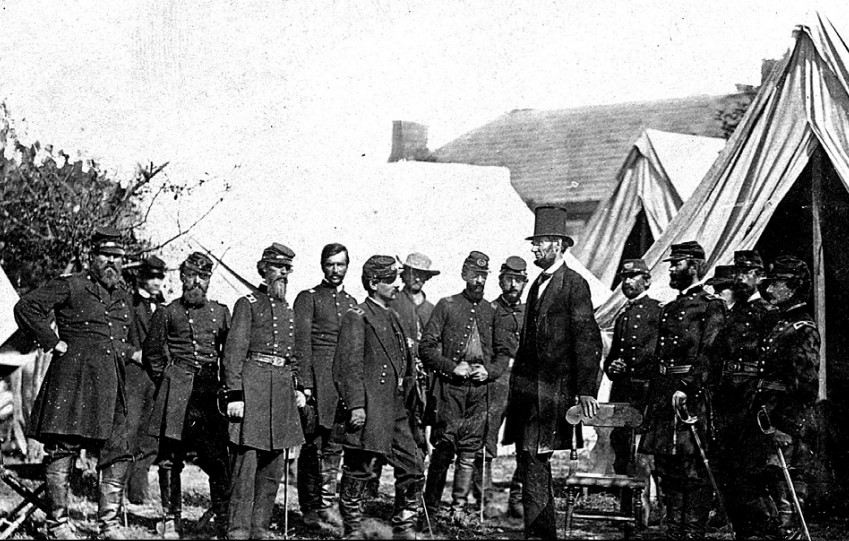 Abraham Lincoln on the battlefield at Antietam / Image: Alexander Gardner
Abraham Lincoln on the battlefield at Antietam / Image: Alexander Gardner
Although some Black infantry units had been formed in Louisiana, Kansas, and South Carolina after the Second Confiscation and Militia Act of July 1862, the first official all-Black unit formed in the aftermath of the proclamation was the famous 54th Massachusetts, raised in early February of 1863 by the abolitionist governor of that state, and depicted in the film Glory. However, even in uniform, the discrimination continued and Black soldiers were paid less than white ones until later in the war.
As we have seen, some 180,000 Black soldiers served in the Union army, roughly 10% of the total. About half were recently escaped former “contrabands”, a quarter were from loyal border states, and the other quarter were free Blacks from the North. Of the 40,000 Black soldiers who died during the war, 10,000 died in combat and another 30,000 died from infection or disease. When Confederates fought or captured Black troops they were especially targeted or massacred outright, as happened at Fort Pillow and the Battle of the Crater during the siege of Petersburg.
It would take several months before Black troops saw major combat, but the war was far from over. Plenty of trials, tribulations, reversals, and close calls remained for the Union – not to mention hundreds of thousands more deaths.
In December of 1862, the Battle of Fredericksburg in Northern Virginia had seen a totally senseless slaughter as Union general Ambrose Burnside sent waves of troops in one futile charge after another against well-entrenched defenders, resulting in nearly 13,000 Union casualties, compared to just over 4,000 on the Confederate side. After the ignominious “mud march”, a failed attempt to manoeuvre around the Confederates to strike at Richmond, Burnside was replaced with General Joseph Hooker in late January 1863.
That May, the Union’s Army of the Potomac faced off again against Robert E. Lee and his key subordinate, Stonewall Jackson, not far from Fredericksburg, Virginia at a small crossroads known as Chancellorsville. This was Lee’s masterpiece battle, as he riskily divided his forces – outnumbered roughly two to one – and sprang a bold and bloody surprise on the Union troops, inflicting 17,000 casualties on Hooker, while suffering just 12,000 himself.
A brilliant tactical victory, it was nonetheless devastating in the long run, as the Union army could sustain these kinds of losses, while the Confederates couldn’t. More immediately, Stonewall Jackson was accidentally shot by his own troops on his way back from a reconnaissance sortie, and he died a few days later, depriving Lee of his most trusted and tested commander. Nonetheless, the victory emboldened Lee to try a second invasion of the North, this time into Pennsylvania. His aim was to strike a blow at Union morale and push the Northern population to turn against the war.
His expedition began in June and culminated in early July in what is almost certainly the most famous battle of the war as over 170,000 soldiers converged on the small town of Gettysburg. Adding to the drama, the newest commander of the Army of the Potomac, George Meade, had only been in charge for a few days when the fighting started.
This was the largest and bloodiest battle of the war, and included the largest artillery barrage in the history of the hemisphere. From the exploits of General Buford’s light cavalry and the Iron Brigade on the first day; to the wholesale slaughter in the Wheatfield, Peach Orchard, and Devil’s Den, the First Minnesota’s charge down Cemetery Ridge, and Joshua Chamberlain and the 20th Maine’s charge down Little Round Top on the second day; to Pickett’s infamous charge on the third day, there were incredible acts of collective and individual heroism and sacrifice on both sides, inspiring countless books, articles, and films.
News of the North’s victory at Gettysburg arrived in Washington on Independence Day, the Fourth of July. That same day, the fall of Vicksburg in Mississippi gave the Union effective control of the Mississippi river, referred to by Lincoln as “the Father of Waters.”
Although the Union had already taken New Orleans, which sits at the mouth of the Mississippi and was the largest city in the Confederacy, strategic portions of the river were still in rebel hands. Referring to Vicksburg, Lincoln had once said: “The war can never be brought to a close until that key is in our pocket.”
For weeks, Ulysses S. Grant had slogged through the swamps in the summer heat, fighting a series of small but brilliant engagements while entirely cut off from his lines of supply and communication before driving the Confederates into the fortress town of Vicksburg. After several failed assaults and a creative and gruelling siege, the defenders were forced to surrender to the relentless pressure of “Unconditional Surrender” Grant, as U.S. Grant had been known since the capture of Fort Donelson.
Many consider the concurrent victories at Gettysburg and Vicksburg to be the decisive turning point in the war, the “high-water mark of the rebellion” – although the war went on for two more carnage-filled years.
Grant takes command
After Grant’s show of tenacity and creativity at Vicksburg, Lincoln knew that he had finally found his general. After so many setbacks and disappointments, he declared: “Grant is my man and I am his the rest of the war!”
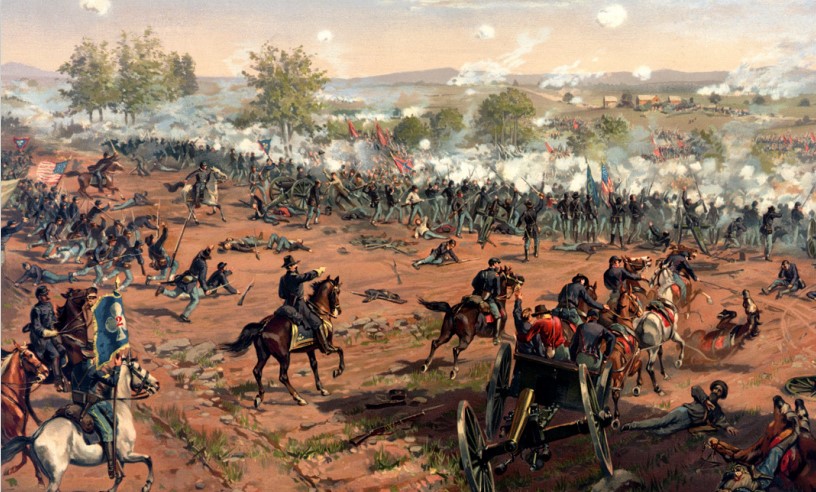 Thure de Thulstrup, Battle of Gettysburg (1887). Fought over July 1–3 1863, it was the largest and bloodiest battle of the war / Image: Adam Cuerden
Thure de Thulstrup, Battle of Gettysburg (1887). Fought over July 1–3 1863, it was the largest and bloodiest battle of the war / Image: Adam Cuerden
Grant was given overall command of Union forces in the West, and there was more bloody fighting in that theatre, including Chickamauga in September – second only to Gettysburg in total casualties – and Chattanooga in November. Chattanooga was a key railroad junction and its fall opened the way to an invasion of Georgia and the deep South, which Sherman would undertake in a few months’ time.
In March of 1864, Grant was transferred to the East to take overall command of the Union forces throughout the country. One Union commander after another had been awed into inaction by the mystique surrounding Robert E. Lee. But Grant knew that, like every other general he had faced, Lee was a man, and not a god – he had actually met Lee once during the war with Mexico.
As an exasperated Grant once told his officers during the Battle of the Wilderness: “Oh, I am heartily tired of hearing about what Lee is going to do. Some of you always seem to think he is suddenly going to turn a double somersault, and land in our rear and on both of our flanks at the same time. Go back to your command, and try to think what we are going to do ourselves, instead of what Lee is going to do.”
Unfortunately, most Americans’ knowledge of Grant is coloured by the pro-Confederate Lost Cause narrative that he was a “drunk,” a bad and corrupt president, and a butcher who didn’t care about the lives of his own men. Only recently have historians begun to acknowledge his real qualities and understated genius, as well as his fundamental honesty and human decency. As Thomas Carlyle did with Oliver Cromwell, they have had to “drag [Grant] out… from under a mountain of dead dogs, a huge load of calumny and oblivion.”
Coordinated offence
In the early stages, the war had been waged almost as though there were several separate small wars going on in different parts of the country, in Missouri, Kentucky, Virginia, on the Atlantic and Gulf coasts, and so on. Without coordination, the many advantages enjoyed by the North could not be capitalised upon.
The Confederates were numerically and economically at a disadvantage. But they had to wage a mainly defensive war and benefitted from interior lines, which allowed them to shift troops as needed from one place to another. Nonetheless, with such a massive territory to try to defend against a numerically and technologically superior enemy, and with a severe lack of resources from the very beginning, the Confederacy could not stop the Union from picking off one strategic stronghold after another, especially in the coastal areas.
As early as January 1862, Lincoln had written the following to one of his generals, Don Carlos Buell:
"I state my general idea of this war to be that we have the greater numbers, and the enemy has the greater facility of concentrating forces upon points of collision; that we must fail, unless we can find some way of making our advantage an overmatch for his; and that this can only be done by menacing him with superior forces at different points, at the same time; so that we can safely attack, one, or both, if he makes no change; and if he weakens one to strengthen the other, forbear to attack the strengthened one, but seize, and hold the weakened one, gaining so much."
With its rapidly growing army and navy the Union was quickly acquiring the means to apply “an unendurable pressure” on the Confederacy. Many in the South recognized this and feared what would happen once the resources of the North were fully brought to bear. Lincoln had had a hell of a time getting his generals to actually implement such a plan. In addition to a general lack of coordination, there was corruption, incompetence, and a series of petty rivalries and distrust within and between the military and civilian commands.
But Grant shared Lincoln’s broad strategic vision for a coordinated effort to end the war, and more importantly, he had the will to grind out a victory no matter what it cost in time, money, and men. Knowing full well that the South did not have infinite resources, Grant’s plan involved the simultaneous mobilisation of five separate Union armies to pressure the Confederates on all sides and prevent them from taking advantage of the interior lines.
He also knew that, along with economic strangulation and the freeing and arming of the slaves, the key to destroying Southern morale once and for all was to smash Lee’s Army of Northern Virginia, which was the embodiment and pride of the Confederate cause. Once these “bodies of armed men” were off the field, the game would be up for the secessionists – and for slavery.
The South didn’t have to take Washington, DC, invade, or occupy the North in order to win. The attempts they did make along these lines were mainly to gain political leverage and were not part of their long-term strategy. They mainly had to resist the Union armies long enough to wear down Northern morale, force peace negotiations, and if at all possible, gain recognition and some kind of support from the world’s major powers.
After emancipation, however, it was going to be virtually impossible to gain British or French recognition. The ruling class in these countries was under heavy pressure from the working class not to support a reactionary slave power. For example, at a meeting called by the London Trades’ Council at St. James’ Hall on 26 March 1863, over 3,000 workers came together to express solidarity and “sympathy with the Northern States of America, and in favour of Negro emancipation.”
This, despite the extreme hardship suffered by British workers due to the lack of Southern cotton for the textile mills.
“Hard war”
The conflict had been transformed from a war merely to preserve the Union into a war to uproot slavery, and there was growing worldwide support for the Union cause. To speed up the end of the war, the Southern economy had to be crippled. Once Lincoln had found audacious and tenacious field commanders willing and able to carry out his policies in a concerted and coordinated way, the economic and demographic might of the North was all but unstoppable.
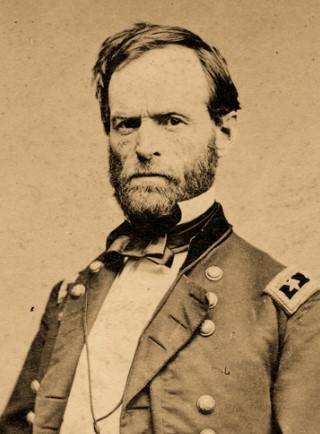 Union generals like William T. Sherman believed that the South must be made to feel the “hard hand of war.” / Image: public domain
Union generals like William T. Sherman believed that the South must be made to feel the “hard hand of war.” / Image: public domain
Union generals like Grant, Sherman, and Philip Sheridan believed that the South must be made to feel the “hard hand of war.” Eventually, the war was taken deep into the heart of the Confederacy, with slaves freed en masse, railroads and other property destroyed, and plantations and foodstuffs expropriated. And while the economy in the North was booming, the Southern economy was in free fall and both its armies and civilians suffered terrible privations.
Generally speaking, civilians were not targeted by either side for mass violence or wholesale massacre. In so many other civil wars, from Antiquity to the present day, the victors rounded people up, executed them, sold them into slavery, and so on. It would be absurd, of course, to argue that there were no abuses as troops criss-crossed the country. Particularly in the border states, there were vicious reprisals against civilians by paramilitary partisans on both sides.
Sherman’s “bummers” weren’t always genteel to the local plantation owners whose goods they expropriated during his march to the sea across Georgia in late 1864. And it is not an unimportant detail that during the Gettysburg campaign, Black residents of Pennsylvania were hunted down and rounded up by Lee’s Army of Northern Virginia, to be sent South into slavery, even if they had never previously been slaves.
But it is fair to say that what happened during the American Civil War was quite different from what would occur when the White Armies occupied areas formerly held by the Reds during the Civil War that followed the Russian Revolution, or how the Romans treated those they conquered in so many of their civil conflicts and wars of conquest. The literature on the war abounds with examples of fraternisation and acts of kindness towards wounded or captured enemy soldiers.
Nevertheless, the “total war” approach, targeting not only the armies, forts, and other strategic points, but also the economy – including slavery – eventually exhausted the South’s morale and capacity to maintain armies in the field.
Grant chased Lee doggedly in a series of bloody battles during the Overland Campaign, from The Wilderness to Spotsylvania Courthouse to Cold Harbor and points in between, and applied overwhelming pressure during the sieges of Petersburg and Richmond. It was a long and brutal grind, and many in the North doubted whether he could actually pull it off.
Philip Sheridan shattered the economy of the Shenandoah Valley in Virginia, which had long been the breadbasket of the Confederacy. And Sherman besieged and eventually took the key city of Atlanta, the burning of which was immortalised in the film Gone With the Wind. He then marched to the coast and Savannah, then up through South Carolina and into North Carolina, cutting a wide swath of destruction as his tens of thousands of soldiers lived off the land.
In Georgia alone, Sherman estimated he had inflicted $100 million in damages – equivalent to around about $1.6 billion in today’s dollars. Around one fifth of this “inured to our advantage,” while the “remainder [was] simple waste and destruction.” His troops wrecked 300 miles of railroad, numerous bridges, and miles of telegraph lines. They seized 5,000 horses, 4,000 mules, and 13,000 head of cattle, and confiscated 9.5 million pounds of corn and 10.5 million pounds of fodder, and as well as destroying an untold number of cotton gins and mills. Nearly 20,000 freed slaves followed in his army’s wake, and were often targeted for murder by vengeful Confederates who could not stand up against the Union army itself.
It was while he was in Savannah that Sherman signed his Special Field Orders 15, which set aside 400,000 acres of confiscated Confederate land so that “each family [of former slaves could] have a plot of not more than forty acres of tillable ground.” Some also received old army mules. This was the origin of the concept of “40 acres and a mule” as a form of reparations for slavery.
The beginning of the end and the end of the beginning
As we’ve seen, the Confederates were unable to gain recognition from the major European powers. So they pinned their hopes on the 1864 elections, when Lincoln’s former top general, George B. McClellan, ran against him as a “peace” candidate on the Democratic Party ticket.
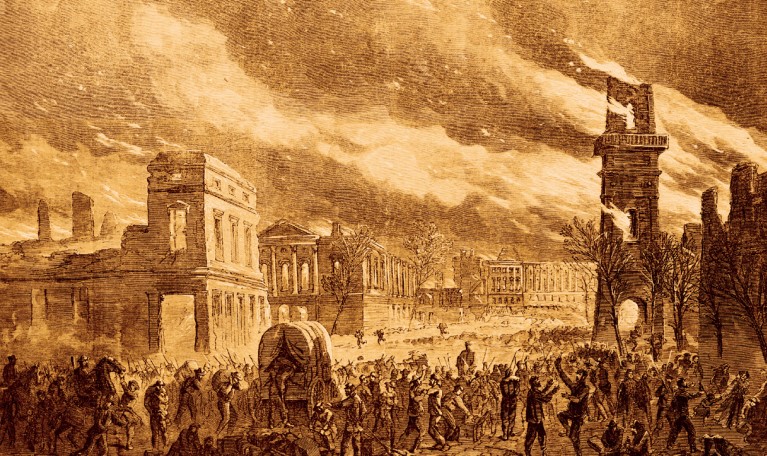 Sherman's troops wreaked "waste and destruction” across the south / Image: William Waud
Sherman's troops wreaked "waste and destruction” across the south / Image: William Waud
The election was, without a doubt, a referendum on the war and emancipation, and even Lincoln himself didn’t think he stood much of a chance. But in the end, he was reelected in a landslide, with overwhelming support among the soldiers – and given a huge boost with the fall of Atlanta coming just a few weeks before the election.
At his Second Inaugural Address, given on 4 March 1865, Lincoln spoke the following powerful words:
"Fondly do we hope, fervently do we pray, that this mighty scourge of war may speedily pass away. Yet, if God wills that it continue until all the wealth piled by the bondsman’s two hundred and fifty years of unrequited toil shall be sunk, and until every drop of blood drawn with the lash shall be paid by another drawn with the sword, as was said three thousand years ago, so still it must be said ‘the judgments of the Lord are true and righteous altogether.’
With malice toward none, with charity for all, with firmness in the right as God gives us to see the right, let us strive on to finish the work we are in."
That work, of course, was a revolutionary war to liberate four million humans from bondage. The presidency had taken a terrible toll on Lincoln’s health. Not only did the stress and strain of the war leave its mark, he had suffered the death of his 11-year-old son Willie while in the White House. But the Great Emancipator saw the war through to the end.
Just a few weeks later, on 2 April 1865 after a long and painful siege, the Confederates succumbed to Grant’s irresistible pressure at the Third Battle of Petersburg and had to abandon Richmond. True to form, seeking only a decisive military victory and not personal glory, Grant immediately continued his pursuit of the Army of Northern Virginia, instead of marching triumphantly into the enemy capital.
The end for Lee and the main force of the Confederate Army came on 9 April, at the tiny crossroads village of Appomattox Courthouse in Virginia. To prevent the war from descending into prolonged guerrillaism and to accelerate the process of national healing, Grant offered Lee and his men extraordinarily lenient terms of surrender.
Less than a week later, on 15 April, Lincoln was assassinated in Ford’s Theater by the renowned actor and pro-Southern zealot, John Wilkes Booth. Vice President Andrew Johnson and Secretary of State Seward were also targeted but survived.
Lincoln’s murder was a significant historical accident and without a doubt, it changed the course of Reconstruction. Things would have almost certainly been significantly different had he been around to use his towering personal authority, political acumen, and ability to change course, when conditions required, to guide the country through what was always going to be a violent and messy process.
Instead, Andrew Johnson of Tennessee presided over the first phase of postwar Reconstruction. And though he hated the Southern planter aristocracy with a passion, he was “no friend to Black people,” as Frederick Douglass had accurately surmised when his gaze connected with Johnson’s at Lincoln’s second inauguration.
The costs of war
In total, the fighting between the Union and Confederacy raged for four years across more than 10,000 battlefields, with some 237 major named battles. The human costs were horrific. Casualty rates ran as high as 30% or more in some battles. At the Battle of Antietam, more soldiers were killed, wounded, or missing than in all previous US wars combined: 23,000 in a single day. For comparison, that’s four times the number of US casualties during the D-Day invasion of Normandy during WWII.
An estimated 624,511 soldiers and sailors died due to battlefield injuries, accidents, or disease during the war. That’s around 2.4% of the 1860 population and would be equivalent to roughly eight million Americans killed today. Hundreds of thousands more were wounded and maimed. On top of this, untold numbers of civilians were killed, wounded, and dislocated.
In the Union Army, your chance of dying was about one in four, more often from disease than from battle. Records for the Confederacy are less precise, but some states suffered a 25% death rate among military-age-males. Incredibly, in 1866, 20% of Mississippi’s entire state budget was spent on artificial limbs.
After the war, Confederate apologists fabricated the myth of the “Lost Cause,” arguing that theirs was a noble cause that was unfortunately doomed to defeat from the beginning, due to the North’s overwhelming economic and demographic superiority. It should go without saying that the cause of perpetuating slavery wasn’t at all noble, but there is an element of truth in their argument.
The population of the Northern states was 18.5 million. The population of the Confederacy was just nine million, and 3.5 million of those were slaves. There were another 2.5 million free inhabitants and 500,000 slaves in the Southern border states that did not secede, and as we’ve seen, troops were raised for both sides from these states. So the raw demographics overwhelmingly favoured the North. Even more decisive was the economy.
In 1860, the South produced less than 10% of US manufactured goods. New York state’s industrial output alone was four times larger than that of the entire South. The South had tried to industrialize in the 1840s to counter the North’s rising industrial strength, but slave labor and mono exports of cotton were too lucrative and entrenched for this to really take off. During the war, the South not only lost its access to the Northern market, but the increasingly effective blockade cut it off from most of the world, though there was, of course, some smuggling both to and from the North and internationally.
In that epoch, railroads were the backbone of the economy, a solid indicator of relative economic development and industrialisation. There were 24,000 miles of railroad in the North at the start of the war, and another 4,000 miles were built during the war. The South had only 9,000 miles at the start, and they built only 400 more. They simply didn’t have the resources to do any more than that.
And when it comes to resources generally, Confederate war spending in 2019 dollars was roughly $23 billion, whereas the Union spent over $68 billion, nearly three times as much.
It is, therefore, fair to say that as long as the North’s will to continue the war remained, it was all but guaranteed to win out in the long run. As is well known, that will to fight on did remain, despite opposition by many, including the violent anti-draft and anti-Black riots in New York in 1863, which were put down by Union troops fresh from the Gettysburg battlefield.
Why fight to defend slavery?
When most people think of Southern slavery, they imagine large plantations with hundreds or even thousands of slaves. In reality, in 1860, just one South Carolina rice plantation had more than 1,000 slaves, and only 13 had between 500 and 1,000 slaves. Most slaves lived on smaller estates with 20 slaves or less.
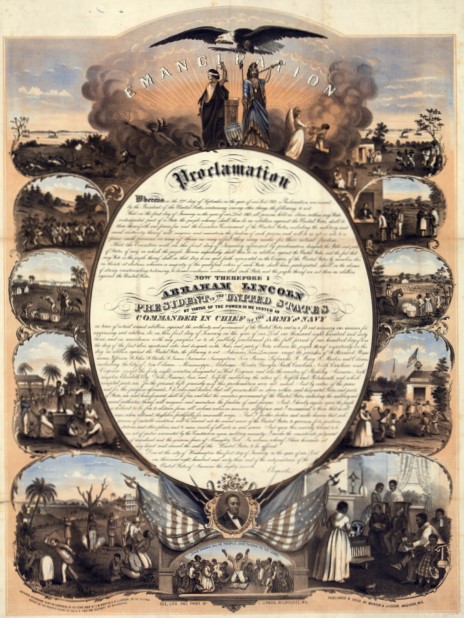 A 1864 printing of the Emancipation Proclamation / Image: public domain
A 1864 printing of the Emancipation Proclamation / Image: public domain
And although most people know that most Southerners did not own any slaves, many are surprised to learn that there were only about 385,000 slaveowners, and that most of them owned fewer than 20 slaves. In terms of direct ownership, the institution of slavery did not affect most people in the Confederacy. And yet, most non-slaveholding white Southerners identified with and defended the institution anyway.
Though many of them resented the wealth, power, and aristocratic arrogance of the large slaveholders, many of them aspired to own slaves themselves and to join the ranks of society’s elite. After centuries of racist scaremongering, the prospect of four million freed slaves terrified them. At root, they saw them as competition for scarce land and jobs.
Slavery gave many poor whites with little or no land someone they could feel superior to. They may have been poor, but at least they weren’t slaves, and they weren’t Black. For many, the reason they fought so tenaciously against the Union was simple, in the words of one Confederate private: “Because you’re down here.”
Two concepts of freedom
Both sides claimed to be fighting for “freedom.” But what kind of freedom? Their definitions ultimately reflected the class basis that prevailed in each half of the country. Did they mean personal freedom and free labour? The freedom to own property? What kind of property? Property in land and human chattels, or in commercial farms and industrial capital? It is crystal clear which form of freedom won in the end – the freedom of capital to exploit wage labour.
The Juneteenth declaration, issued on 19 June 1865 by Union Major General Gordon Granger in Galveston, Texas shortly after the end of the war sums it up concisely:
"The people of Texas are informed that, in accordance with a proclamation from the Executive of the United States, all slaves are free. This involves an absolute equality of personal rights and rights of property between former masters and slaves, and the connection heretofore existing between them becomes that between employer and hired labor. The freedmen are advised to remain quietly at their present homes and work for wages. They are informed that they will not be allowed to collect at military posts and that they will not be supported in idleness either there or elsewhere."
What is indisputable is that the freeing of the slaves ranks as one of the biggest revolutionary expropriations without compensation in the whole of human history. It was the mass action of the slaves themselves that forced Lincoln and his generals’ hands. And it was their heroism in battle that further radicalised Northern public opinion in favour of abolition.
As we’ve seen, hundreds of thousands of slaves risked their lives to run away, joined the Union army, and otherwise resisted, sabotaged, and hobbled the Southern economy in what WEB DuBois described as a slave “general strike.” However, as one former plantation owner put it: “Emancipated slaves own nothing, because nothing but freedom has been given to them.”
The ultimate bourgeois revolution
The Civil War and the period of Reconstruction that followed represent the last great push of the bourgeoisie as a historically progressive class. In fact, the American Civil War was perhaps the most classical bourgeois revolution of all, insofar as in previous revolutions, the capitalist class did not play as conscious and direct a role as a class in imposing their preferred class and property relations on the nation as a whole.
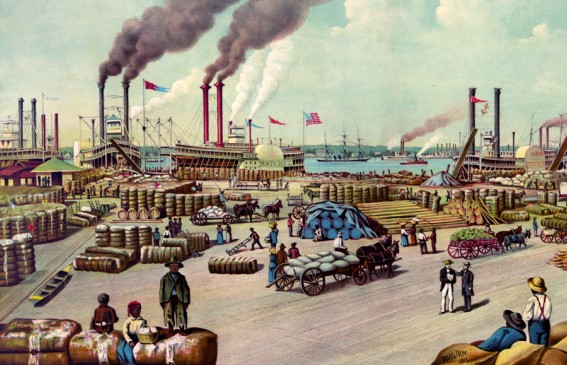 The Levee, New Orleans by William A. Walker (1884) / Image: William A. Walker
The Levee, New Orleans by William A. Walker (1884) / Image: William A. Walker
Not only did the North use the war and its aftermath to break up or accelerate the break up of non-capitalist forms of exploitation and production throughout the country, it also used the upheaval to consolidate the state institutions that established the political and legal framework for untrammelled capitalist accumulation and expansion in the century that followed.
Take the US dollar, for example. Before the war, the only currency issued by the federal government was gold and silver coins, or specie. There were hundreds of different banknotes issued by private banks, exchangeable for specie in limited areas serviced by those specific banks. Lincoln’s Secretary of the Treasury was none other than Salmon P. Chase – the namesake of today’s Fortune 500 bank. On 25 February 1862, the first Legal Tender Act was passed, and the federal government started issuing what became known as greenbacks, which had far-reaching consequences on the development of the economy and the role and power of the federal government.
The war also led to unprecedented centralisation in order to finance and mobilise the human and material resources required for victory: with tariffs, taxes, a military draft and even partial nationalisation of the railroads and telegraphs. It essentially forged the modern United States as we know it today.
But as with all bourgeois revolutions, this immensely progressive movement could not eradicate all exploitation and oppression. Ultimately, it could go no further than to raise one class of property owners over another, more reactionary class, and consolidate its grip on the repressive powers of the state, albeit in a more democratic form. It was in this modern form that the American capitalists pursued their genocidal wars against the native peoples of the continent, unleashed vicious lynch mobs against black workers, farmers, and sharecroppers, and built up the most ferocious imperialist power in the history of mankind.
We need not prettify this monster to appreciate the significance of its birth, which forged the nation we live in today and set the stage for the next American revolution – the socialist revolution. With slavery swept aside, the productive forces developed by leaps and bounds and with them, the working class which soon emerged as a revolutionary force and a contender for power.
As Marx wrote in Capital: “In the United States of North America, every independent movement of the workers was paralysed so long as slavery disfigured a part of the Republic. Labour cannot emancipate itself in the white skin where in the black it is branded. But out of the death of slavery a new life at once arose. The first fruit of the Civil War was the eight hours’ agitation, that ran with the seven-leagued boots of the locomotive from the Atlantic to the Pacific, from New England to California.”
Just a few years later, in 1871, the world witnessed the Paris Commune, the first seizure of power by the working class. All major worldwide revolutionary movements since then have had at least one foot clearly on the proletarian revolution side of history.
Today, only the mighty American working class can carry out the democratic and social tasks that were left unfinished by the Civil War and Reconstruction. In the history of the Civil War we find a proud heritage of revolutionary determination and sacrifice. For this reason, every class-conscious worker should study the events and lessons of this epoch-making period in preparation for the titanic struggles to come.
Due to the large number of references featured in this article, we have chosen not to publish the full list of citations here.
For a full list of citations, please visit: https://www.marxist.com/the-civil-war-america-s-second-revolution.htm

